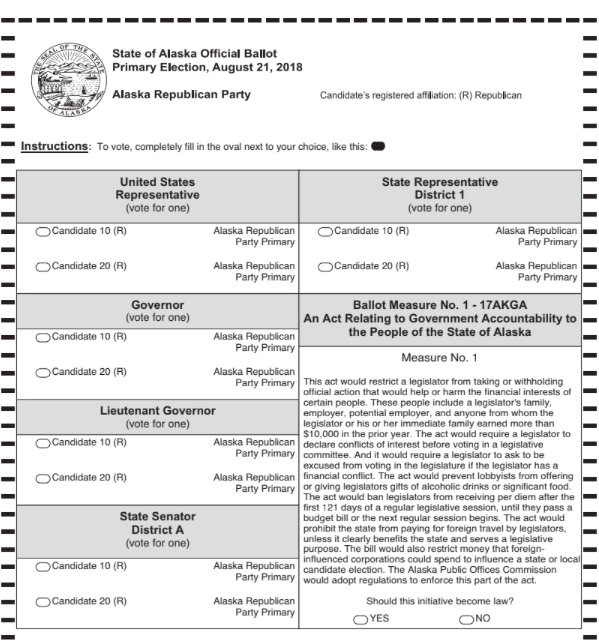THE ADL BALLOT GETS MORE COMPLICATED
The move last year by the Alaska Democratic Party to allow undeclared and nonpartisan candidates to run on the party’s Primary ballot caused the Alaska Division of Elections to remodel both the Primary and General Election ballots.
Democrats want Gov. Bill Walker at the top of their ticket this year, as they did in 2014, but he can’t join the party, or he’d go down in flames at the ballot box.
They want him to be able to run as an “undeclared” candidate, but still on their Primary ballot.
The courts have said they may do so.
The confusion comes because when Walker and Lt. Gov. Byron Mallott, who is a Democrat, run under the Democrat umbrella, how will voters know if they are Democrats or something else?
The Supreme Court told the Division to sort it out: It must make it clear to the voters that although a “don’t-ask-don’t-tell candidate” may run on the Democrats’ ballot, there needs to be some transparency. In other words, don’t play fast and loose with the facts, Alaska Democrats.
The draft ballots are now out from the Division of Elections in response to the court’s order to allow Walker/Mallott to be the Democrats’ combo meal. Here’s what the ballots look like, (and these are just samples):

THE ADL ‘CONFUSION BALLOT’
For the primary election, all voters can choose the ADL ballot, which has Democrats, Alaska Independence Party, Libertarians candidates, as well as a mishmash of minor parties.
Undeclared and nonpartisan voters can instead choose the Republican ballot, which is a ballot that has just Republican candidates. Registered Democrats (or those registered with another party) don’t get to vote this ballot, a decision upheld by the U.S. Supreme Court.
Those who choose the ADL Primary ballot will not, for example, see the name of Rep. Don Young, who is running for re-election. His name will appear on the Republican primary ballot. This is how it has always worked. They’ll see Alyce Galvin’s name — she is a nonpartisan who is running under the Democrats’ umbrella and with their resources.
If voters choose the ADL ballot, they might see Gov. Bill Walker’s name, and the letter “U” next to it for undeclared, and then the words “Democratic Party Primary,” if he is the winner of that primary.
They won’t see the names of Mike Dunleavy, Scott Hawkins, Mike Chenault or Michael Sheldon, who are Republican candidates for governor. Those names will be on the Republican ballot.
The Libertarian candidate will be listed on the ADL ballot, with an “L” next to his or her name, and the words Libertarian Party Primary … Unless an undeclared wants to run under the Libertarian banner. Then, all bets are off. There’s no final determination yet if the Libertarians can keep someone from running under their banner; Republicans may take this question to court to keep Reps. Gabrielle LeDoux, Paul Seaton, and Louise Stutes off their primary ballot.
Lt. Gov. Byron Mallott will not be paired with Walker on the primary ballot, although the two are clearly running as a virtual ticket. He will be on his own slot on the ballot under the Lieutenant Governor box, where he’ll have to duke it out with anyone else who defies the Democratic Party and files as a Democrat for that seat.
In his case, his name will be listed Byron Mallott (D) Democratic Party Primary.
If Walker/Mallott advance to the General Election, they’ll be listed together as a ticket in November:
- Bill Walker (U) Alaska Democratic Party Nominee
Byron Mallott (D)
However, if another person — such as Mark Begich — wins as the Democrats’ nominee, Mallott (if he wins) would be paired with Begich on the General Election ballot.
REPUBLICAN PARTY BALLOT
Of the two, the Republican ballot will be the most easy to understand, because there isn’t any tomfoolery on it. Candidates who are on this ballot will be registered Republicans, and won’t have a U, N, or other letter by their names.

NOMINATING PETITION PROCESS
This year, several liberal candidates have chosen to run as undeclared or nonpartisans. Some of them may run on the Democrats’ primary ballot, while others may choose to go in as petition candidates, skip the primary, and head straight to the General Election.
That’s what Gov. Bill Walker did in 2014, although he formed a hybrid ticket with the Democrats when they agreed to withdraw their gubernatorial candidate, and allow him to game the system into an election victory.
For example of how the petition process works, undeclared Chris Dimond, who is running for House in District 33 Juneau, is skipping the Primary ballot and will appear on the General Election ballot with the letter “U” by his name and the words “Nominating Petition” where the party would normally be listed.
Sara Hannan and Steve Handy, will be listed as Democrats for that seat, and one will be on the Primary ballot and will appear that way on the General ballot.
Here’s the list of non-party legislative candidates, so far, who have filed and who could either run under the Democrat banner in the Primary, or skip the Primary ballot and be “petition” candidates in the General.
- Shawn Butler, nonpartisan, District 29 Kenai
- Larry Cotter, nonpartisan, District Q, Juneau
- Chris Dimond, undeclared, District 33, Juneau
- Don Etheridge, undeclared, Senate District Q, Juneau
- Sandra Katelnikoff-Lester, nonpartisan District 32, Kodiak
- Danyelle Kimp, nonpartisan, District 13, Eagle River (did not indicate if running for House or Senate)
- Timothy Lamkin, nonpartisan, District 4, Fairbanks
- Daniel Ortiz, undeclared, District 36, Ketchian
- Jason Grenn, nonpartisan, District 22, Anchorage
FILING DEADLINES AND SWITCHAROOS
Candidates have until 5 pm June 1 to file for the Primary; they have to decide which direction they’ll go — petition candidate or Primary candidate.
Then, if they file with a party but then change their minds and want to file without a party, they must file as a petition candidate for the General Election before 5 pm on Aug. 21, which is the same day as the Primary Election.
This means candidates would have to re-file before the results of the Primary are known, as voting ends three hours after the filing deadline.
Complicating matters, the candidate would have had to withdraw from the Primary before filing for the General Election as a petition candidate. That drop-out date is several weeks earlier — July 2.
Hence, this calendar is Gov. Walker’s hammer against Mark Begich.
If Begich jumps in the race on the Democrats’ Primary ballot, Walker would have a decision to make: Either a head-to-head with Begich, or drop out by July 2 and file as a petition candidate before Aug. 21.
All eyes will be on the Division of Elections at the close of business on June 1.

A lot of non partisan candidates in the race. This election season will be a confusing one.
What happens if a citizen sues about the “all” but the Republican Party Ballot, being too confusing with the potential of non-comprehension. I am glad now that the Republican Primary is closed with a true line to a clean vote!
If one wanted to vote Republican and Libertarian can it be done??? Will this election be a sham if that becomes the case either way? Ink will take shape on any paper Ballot whether or not the Election Division makes a call on this up- coming vote…beware Alaskans! I feel like I may be voting in a Bush Community before this is over. Ha ha
Only if they vote in House District 40. And probably only the one time, back in ’16. It would be pretty messy if the Lite GOV directed that tomfoolery again.
Oh, this should make for an interesting primary ?
How about we just don’t try to game the system and list everyone. You can vote for whoever you feel is best qualified no matter how you or they are registered.
Listen to Michael Sheldon discuss how we will fix Alaska’s Economy.
https://www.krbd.org/2018/05/23/sheldon-makes-campaign-stop-in-ketchikan/